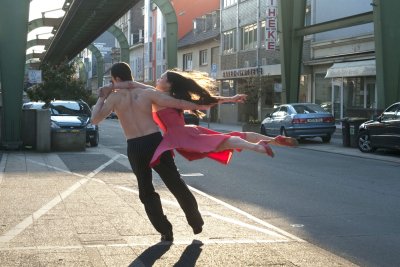Reviews - Pina
Pina
Reviewed By John Stakes

Pina
A collaboration between one of the world’s most celebrated German film directors, (using a reinvigorated medium for the first time to produce the world’s first 3-D art-house movie), and an iconic single-minded German ballet and dance choreographer, proved irresistible to many Club members last Sunday.
Foregoing their usual promenading through the back streets of Keswick, well over one hundred club members, friends et al ventured forth (not quite in convoy) along the A66 to Rheged’s giant Imax screen, to see whether they too would witness, as the director of “Pina” described his own experience of the work of fellow countryman Pina Bausch, as being “a spectacle of grown men (and presumably women) crying helplessly on the edge of their seats”.
Unfortunately circumstances combined to deny this reviewer the opportunity of sharing this experience, but judging from the audience vote Wim Wender’s account in 3-D of the life and work of Pina Bausch proved to be one of the most popular films of the whole year. It was not in fact quite the collaboration intended as Pina unfortunately died aged sixty eight on the 30th June 2009, only two days before the planned first rehearsal shoot following a year’s intensive pre-production
work. Wenders agonised as to whether the film could or should still be made, but, fortunately for us and with the backing of her dancers through whom she still lived, the decision was made to continue.
At this point Wenders had become hugely enthusiastic about 3-D, seeing film in this format as not only taking the audience across the stage footlights and on to the stage, but bringing a whole new depth to cinematic art. At the same time he regarded Pina’s work as an ideal showcase for presentation in this way. By all accounts he was right.
“Dance for otherwise we are lost” was Pina’s rallying cry. Born Philppine Bausch in Solingen in 1940 this innkeeper’s daughter was a great observer of people. Her training under Kurt Jooss reconciled the free spirit of dance with the strict formality and technical rigour of ballet. She was also influenced in her thinking by several other art forms including photography, drama, opera, and music. Grant aided in 1958 she travelled to New York where she teamed up with the Martha Graham dancers and Antony Tudor, staying on for another year at her own expense.
Following her return to Germany (Essen) she was appointed head of Wuppertal Ballet which she immediately renamed “Tunztheater” (the name reverting to the 1920s and standing for disengagement from mere dance routines and for opening up freedom of choice and expression). Thus her dancers were encouraged to infuse her work with their own personalities. This idiosyncratic and original approach took time to refine and gain acceptance. In 1978 for example Pina developed her own version
of Macbeth but fell out even with her own troupe as little conventional dancing was involved, eventually taking to the stage with four dancers, five actors and a singer, much to the annoyance of the audience which revolted!
She therefore reverted to the basics of human emotion and reconstructed her approach to take a fresh look at reality. Her work took off and paid off. She eventually produced nearly fifty original pieces leading to her being honoured with (amongst others) the German Dance Award in 1995 and The Nijinsky Award in Monte Carlo in 2005.
Little needs to be said about Wenders’ love of this film and the medium of 3-D. However others have not found his use of this format quite so involving and exciting. Earlier this year Wenders was selected for the 2013 staging of Wagner’s Ring cycle at the Bayreuth Festival as a reflection of his capacity to produce imaginative tributes to great works of art. The project fell through when he insisted on filming in 3-D, which the Wagner family found too costly and disruptive!
As for 3-D we’ve come a long way since the grand-father of cinema William Friese-Greene first filed a patent for a 3-D movie in the 1890s. His version involved projecting two films side by side with the viewer staring into a stereoscope which brought the two images together. Following a resurgence of interest in the 1950s using those quaint tinted glasses, by 2005 Spielberg was patenting a 3-D camera which made them redundant, and the digital age has enabled 2-D films to be converted to 3-D format. The complaint now is that the market has become saturated with inferior 2-D conversions and the public is not prepared to be burdened with the additional cost. Whatever else, cinema continues to evolve, provoke and entertain.
Foregoing their usual promenading through the back streets of Keswick, well over one hundred club members, friends et al ventured forth (not quite in convoy) along the A66 to Rheged’s giant Imax screen, to see whether they too would witness, as the director of “Pina” described his own experience of the work of fellow countryman Pina Bausch, as being “a spectacle of grown men (and presumably women) crying helplessly on the edge of their seats”.
Unfortunately circumstances combined to deny this reviewer the opportunity of sharing this experience, but judging from the audience vote Wim Wender’s account in 3-D of the life and work of Pina Bausch proved to be one of the most popular films of the whole year. It was not in fact quite the collaboration intended as Pina unfortunately died aged sixty eight on the 30th June 2009, only two days before the planned first rehearsal shoot following a year’s intensive pre-production
work. Wenders agonised as to whether the film could or should still be made, but, fortunately for us and with the backing of her dancers through whom she still lived, the decision was made to continue.
At this point Wenders had become hugely enthusiastic about 3-D, seeing film in this format as not only taking the audience across the stage footlights and on to the stage, but bringing a whole new depth to cinematic art. At the same time he regarded Pina’s work as an ideal showcase for presentation in this way. By all accounts he was right.
“Dance for otherwise we are lost” was Pina’s rallying cry. Born Philppine Bausch in Solingen in 1940 this innkeeper’s daughter was a great observer of people. Her training under Kurt Jooss reconciled the free spirit of dance with the strict formality and technical rigour of ballet. She was also influenced in her thinking by several other art forms including photography, drama, opera, and music. Grant aided in 1958 she travelled to New York where she teamed up with the Martha Graham dancers and Antony Tudor, staying on for another year at her own expense.
Following her return to Germany (Essen) she was appointed head of Wuppertal Ballet which she immediately renamed “Tunztheater” (the name reverting to the 1920s and standing for disengagement from mere dance routines and for opening up freedom of choice and expression). Thus her dancers were encouraged to infuse her work with their own personalities. This idiosyncratic and original approach took time to refine and gain acceptance. In 1978 for example Pina developed her own version
of Macbeth but fell out even with her own troupe as little conventional dancing was involved, eventually taking to the stage with four dancers, five actors and a singer, much to the annoyance of the audience which revolted!
She therefore reverted to the basics of human emotion and reconstructed her approach to take a fresh look at reality. Her work took off and paid off. She eventually produced nearly fifty original pieces leading to her being honoured with (amongst others) the German Dance Award in 1995 and The Nijinsky Award in Monte Carlo in 2005.
Little needs to be said about Wenders’ love of this film and the medium of 3-D. However others have not found his use of this format quite so involving and exciting. Earlier this year Wenders was selected for the 2013 staging of Wagner’s Ring cycle at the Bayreuth Festival as a reflection of his capacity to produce imaginative tributes to great works of art. The project fell through when he insisted on filming in 3-D, which the Wagner family found too costly and disruptive!
As for 3-D we’ve come a long way since the grand-father of cinema William Friese-Greene first filed a patent for a 3-D movie in the 1890s. His version involved projecting two films side by side with the viewer staring into a stereoscope which brought the two images together. Following a resurgence of interest in the 1950s using those quaint tinted glasses, by 2005 Spielberg was patenting a 3-D camera which made them redundant, and the digital age has enabled 2-D films to be converted to 3-D format. The complaint now is that the market has become saturated with inferior 2-D conversions and the public is not prepared to be burdened with the additional cost. Whatever else, cinema continues to evolve, provoke and entertain.
Find A Film
Search over 1475 films in the Keswick Film Club archive.
Friends
KFC is friends with Caldbeck Area Film Society and Brampton Film Club and members share benefits across all organisations
Awards
Keswick Film Club won the Best New Film Society at the British Federation Of Film Societies awards in 2000.
Since then, the club has won Film Society Of The Year and awards for Best Programme four times and Best Website twice.
We have also received numerous Distinctions and Commendations in categories including marketing, programming and website.
 Talking Pictures
The KFC Newsletter
Talking Pictures
The KFC Newsletter
Links Explore the internet with Keswick Film Club


